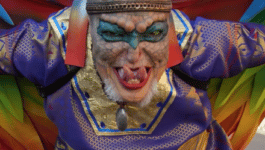by Ricky Chelette, Executive Director
“What am I?” should not be the question we ask ourselves as humans, for what we are, humans, should be self-evident. But is it?
In a world where what we are is determined by how we feel about ourselves, we are fast approaching a time when “what” may be the more definitive understanding.
Orthodox understandings of God’s creative, intentional, and purposeful work of creating humans as male and female have escaped progressive comprehension. We now live in a world where observable reality is not as real as experienced feelings. Children are said to be assigned a sex at birth rather than affirmed or recognized by visible genitalia or chromosomal fact.
I believe the amount of incongruency demonstrated in the modern narrative radically contributes to the confusion people are experiencing in our culture. Children, barely old enough to understand the world around them or safely navigate their home, are deciding their gender and how they want to express their life for the rest of their earthbound days.
Identity Confusion
“Marcus Evans, a psychotherapist and former governor of the Tavistock and Portman NHS Foundation Trust, resigned in February 2019, citing an institutional rush to prescribe puberty-blocking hormone treatment to children questioning their gender and who may wish to transition. “The Tavistock is behaving recklessly with these kids who are in a distressed state,” he claims.”[1]
The same article states,
“The WPATH [World Professional Association for Transgender Health] guidelines say that ‘children as young as two may show features that could indicate gender dysphoria. They may… prefer clothes, toys and games commonly associated with the other sex and may prefer playing with other-sex peers.’
A very distinct perspective is on show here: one that venerates individual feelings of identity, and yet also regards the social categories of gender with such solemnity that a girl toddler’s fondness for toy tractors is now seen as a marker of dysphoria. There is little room for interrogating either the feelings or the categories: it’s the biology that needs to change.”[2]
On the one hand, the LGBTQIA+ community abhors labels and stereotypes, while on the other hand, they enforce rigid socially constructed understandings of masculine and feminine expression. They quickly assert that sex is assigned, and gender is a social construct. Yet, a child inherently being drawn to something considered stereotypically associated with male or female (ironically indicating the reality of a binary existence) is considered proof that the child is gender dysphoric. Both things cannot be true.
What if there are other reasons for youths’ gender confusion? What if children are born with a sex and a gender congruent with their sex? Instead of rushing into chemical treatments that delay the natural course of physical development, we explore other factors influencing a person’s perception of themselves.
Articles abound with proclamations of the mental stress inflicted by nearly three years of pandemic lockdowns and social isolation. Youth spend six to eight hours daily on social media ingesting endless amounts of curated information designed to affirm whatever they are feeling.[3] Most parents have little knowledge of what their child is viewing and even less understanding of how messages contained in media shape their child’s worldview and sense of self.
If feelings define us…
If feelings define us, where does this lead? Taken to its consequential conclusion, the notion of transspecies is now becoming a plausible possibility – at least in the minds of some.

Tourjée observes, “Tiamat doesn’t seem like a human. She seems like a dragon, a mythical entity that has, through a series of ritualistic procedures, managed to escape the confines of the human body.”[5]
Tourjée, and most folks responding to Tiamat’s social postings, affirm and celebrate Tiamat’s transformation. Children are fascinated by Tiamat’s appearance and drawn to the uniqueness of Tiamat’s transformation.

Tiamat is not alone. Dennis Avner transformed his body into a tiger, spending over $200,000 to modify his body to agree with how he felt like a cat.[6] And Tom Peters of the UK lives as a human puppy.[7]
Please know that I am NOT saying that these outlying individuals are equivalent to the psychological condition of gender dysphoria. However, I am saying that if we adopt the reasoning that, “I am what I feel I am,” such identities are logical conclusions to a faulty premise. Individuals seeking to alleviate distress in their lives (brought on by trauma, perceived or actual) might find solace and even affirmation in becoming something other than their God-created, natal self.
What can you do?
What can parents do if their child believes they are something different than what God created them to be?
- Listen to what your child has to say. What are they communicating to you? Don’t quote bible verses. If you have lived out your faith before them they should know what the Word teaches.
- Ask more questions than you make proclamations. Explore why your child feels as she does. When did she first feel this way? How did he come to this conclusion? What would this look like if she embraced this feeling fully? What would life be like in 5, 10, or even 20 years? If God is our creator, how does this fit into His sovereign plan for creation?
- Express your genuine love for your child. Let your child know they are loved where they are as they are. Assure them that you are on this journey with them and desire to see them live out God’s design and plan for their lives. You are not compromising your beliefs when you love your child where he is while encouraging him toward what is even better.
- Seek professional, godly help and guidance. Finding a Christ-centered, Christ-following therapist or counselor is critical. Interview the therapist before they see your child. Be sure the counselor is supportive of your biblical worldview.
- Pray and persevere. Identity issues are generally deeply rooted in a person’s psyche. They can be the results of hurts and struggles unrecognized for decades. God desires to bring healing and wholeness but discovering the roots of struggles and working through past hurts can be painful and difficult. Be patient, pray, and trust God. He will not disappoint (Rom. 10:11).
Reality Check
We need a reality check. We are living untethered from truth, adrift in our self-absorbed, pleasure-seeking world. The results are tragic.
We need to return to God. Parents must teach their children our place in God’s incredible world. As humans, we are God’s most glorious creation. We are image-bearers of God in this world, not image creators. We, as humans, are the ones for whom Christ left heaven, entered our world, took on our form, and suffered to redeem us. We are the creation that disrupted the tranquility of Eden and caused ourselves and all creation to need redemption. We are the creation God is reconciling to Himself (1 Cor. 15).
What am I? I am a sinner who needs redemption (Rom. 5;12). But the glorious good news is that Christ has redeemed me if I put my faith in Him (Rom. 10:9). I am not left alone to figure things out for myself. He is with me, and His Word guides my way (Jn. 14:15-16). Knowing Him and experiencing His love for me gives me the vision to see who I am in Him regardless of how I may feel. I am His beloved son (or daughter) (Col. 3:12), and my Father has a future for me and a place prepared for me (Jn. 14:3).
[1] Emma Hartley, April 2020. Why do so many teenage girls want to change gender? Prospect. https://www.prospectmagazine.co.uk/magazine/tavistock-transgender-transition-teenage-girls-female-to-male June 2022.
[2] Ibid
[3] Apurvakumar Pandya and Pragya Lodha. Front. Hum. Dyn., 22 July 2021. Social Connectedness, Excessive Screen Time During COVID-19 and Mental Health: A Review of Current Evidence. https://www.frontiersin.org/articles/10.3389/fhumd.2021.684137/full June 2022.
[4] Diana Tourjée, Sept. 20, 2018. I’m A Real-Life Transgender Dragon, Vice Life. https://www.youtube.com/watch?v=_d_nycoiLwo June 2022.
[5] Ibid.
[6] Animal Imitators (Extreme Body Modification Documentary) | Only Human https://www.youtube.com/watch?v=lS3l1JLBo6A June 2022.
[7] Holly Willoughby and Phillip Schofield, May 24, 2016. Holly and Phillip Meet The Human Puppy, This Morning. https://www.youtube.com/watch?v=gHttU1Baymo June 2022.
